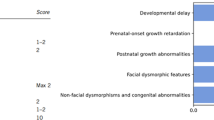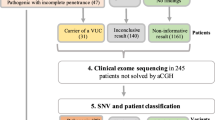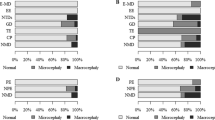Abstract
Array comparative genomic hybridization (aCGH) is a powerful genetic tool that has enabled the identification of novel imbalances in individuals with intellectual disability (ID), autistic disorders and congenital malformations. Here we report a ‘genotype first’ approach using aCGH on 13 unrelated patients with 19p13.3 submicroscopic rearrangement (11 deletions and 2 duplications) and review cases in the literature and in public databases. Shared phenotypic features suggest that these patients represent an interstitial microdeletion/microduplication syndrome at 19p13.3. Common features consist of abnormal head circumference in most patients (macrocephaly with the deletions and microcephaly with the duplications), ID with developmental delay (DD), hypotonia, speech delay and common dysmorphic features. The phenotype is associated with at least a ~0.113 Mb critical region harboring three strong candidate genes probably associated with DD, ID, speech delay and other dysmorphic features: MAP2K2, ZBTB7A and PIAS4, an E3 ubiquitin ligase involved in the ubiquitin signaling pathways, which we hypothesize for the first time to be associated with head size in humans.
Similar content being viewed by others
Log in or create a free account to read this content
Gain free access to this article, as well as selected content from this journal and more on nature.com
or
References
Grimwood J, Gordon LA, Olsen A et al: The DNA sequence and biology of human chromosome 19. Nature 2004; 428: 529–535.
Dolan M, Mendelsohn NJ, Pierpont ME : A novel microdeletion/microduplication syndrome of 19p13.13. Genet Med 2010; 12: 503–511.
Kosaki K, Saito H, Kosaki R, Torii C, Kishi K, Takahashi T : Branchial arch defects and 19p13.12 microdeletion: defining the critical region into a 0.8 M base interval. Am J Med Genet A 2011; 155A: 2212–2214.
Archer HL, Gupta S, Enoch S et al: Distinct phenotype associated with a cryptic subtelomeric deletion of 19p13.3-pter. Am J Med Genet A 2005; 136: 38–44.
Peddibhotla S, Kaslifa M, Probst FJ et al: Expanding the genotype-phenotype correlation in subtelomeric 19p13.3 microdeletions using resolution clinical chromosomal microarray analysis. Am J Med Genet A 2013; 161A: 2953–2963.
Souza J, Faucz F, Sotomaior V, Filho AB, Rosenfeld J, Raskin S : Chromosome 19p13.3 deletion in a child with Peutz-Jeghers syndrome, congenital heart defect, high myopia, learning difficulties and dysmorphic features: Clinical and molecular characterization of a new contiguous gene syndrome. Genet Mol Biol 2011; 34: 557–561.
Ishikawa A, Enomoto K, Tominaga M, Saito T, Nagai J, Furuya N, Ueno K, Ueda H, Masuno M, Kurosawa K : Pure duplication of 19p13.3. Am J Med Genet A 2013; 161: 2300–2304.
Tentler D, Gustavsson P, Elinder G et al: A microdeletion in 19q13.2 associated with mental retardation, skeletal malformations, and Diamond-Blackfan anaemia suggests a novel contiguous gene syndrome. J Med Genet 2000; 3: 128–131.
Zung A, Rienstein S, Rosensaft J, Aviram-Goldring A, Zadik Z : Proximal 19q trisomy: a new syndrome of morbid obesity and mental retardation. Horm Res 2007; 67: 105–110.
Malan V, Raoul O, Firth HV : 19q13.11 deletion syndrome: a novel clinically recognisable genetic condition identified by array comparative genomic hybridisation. J Med Genet 2009; 46: 635–640.
Chowdhury S, Bandholz AM, Parkash S et al: Phenotypic and molecular characterization of 19q12q13.1 deletions: a report of five patients. Am J Med Genet A 2013; 164A: 62–69.
Miller DT, Adam MP, Aradhya S et al: Consensus statement: chromosomal microarray is a first-tier clinical diagnostic test for individuals with developmental disabilities or congenital anomalies. Am J Hum Genet 2010; 86: 749–764.
Vermeesch JR, Brady PD, Sanlaville D, Kok K, Hastings RJ : Genome-wide arrays: quality criteria and platforms to be used in routine diagnostics. Hum Mutat 2012; 33: 906–915.
Shaffer LG, Theisen A, Bejjani BA : The discovery of microdeletion syndromes in the post-genomic era: review of the methodology and characterization of a new 1q41q42 microdeletion syndrome. Genet Med 2007; 9: 607–616.
Mefford HC, Sharp AJ, Baker C et al: Recurrent rearrangements of chromosome 1q21.1 and variable pediatric phenotypes. N Engl J Med 2008; 359: 1685–1699.
Palomares M, Delicado A, Mansilla E et al: Characterization of a 8q21.11 microdeletion syndrome associated with intellectual disability and a recognizable phenotype. Am J Hum Genet 2011; 89: 295–301.
Molin AM, Andrieux J, Koolen DA et al: A novel microdeletion syndrome at 3q13.31 characterised by developmental delay, postnatal overgrowth, hypoplastic male genitals, and characteristic facial features. J Med Genet 2012; 49: 104–109.
Al-Kateb H, Hahn A, Gastier-Foster JM, Jeng L, McCandless SE, Curtis CA : Molecular characterization of a novel, de novo, cryptic interstitial deletion on 19p13.3 in a child with a cutis aplasia and multiple congenital anomalies. Am J Med Genet A 2010; 152A: 3148–3153.
de Smith AJ, van Haelst MM, Ellis RJ : Chromosome 19p13.3 deletion in a patient with macrocephaly, obesity, mental retardation, and behavior problems. Am J Med Genet A 2011; 155A: 1192–1195.
Risheg H, Pasion R, Sacharow S et al: Clinical comparison of overlapping deletions of 19p13.3. Am J Med Genet A 2013; 161A: 1110–1116.
Siggberg L, Olsén P, Näntö-Salonen K, Knuutila S : 19p13.3 aberrations are associated with dysmorphic features and deviant psychomotor development. Cytogenet Genome Res 2011; 132: 8–15.
Nowaczyk MJ, Thompson BA, Zeesman S et al: Deletion of MAP2K2/MEK2: a novel mechanism for a RASopathy? Clin Genet 2013; 85: 138–146.
Vallespín E, Palomares Bralo M, Mori M et al: Customized high resolution CGH-array for clinical diagnosis reveals additional genomic imbalances in previous well-defined pathological samples. Am J Med Genet A 2013; 161A: 1950–1960.
Bejjani BA, Theisen AP, Ballif BC, Shaffer LG : Array-based comparative genomic hybridization in clinical diagnosis. Expert Rev Mol Diagn 2005; 5: 421–429.
Duker AL, Ballif BC, Bawle EV et al: Paternally inherited microdeletion at 15q11.2 confirms a significant role for the SNORD116 C/D box snoRNA cluster in Prader-Willi syndrome. Eur J Hum Genet 2010; 18: 1196–1201.
Ballif BC, Theisen A, Coppinger J et al: Expanding the clinical phenotype of the 3q29 microdeletion syndrome and characterization of the reciprocal microduplication. Mol Cytogenet 2008; 1: 8.
Traylor RN, Fan Z, Hudson B et al: Microdeletion of 6q16.1 encompassing EPHA7 in a child with mild neurological abnormalities and dysmorphic features: case report. Mol Cytogenet 2009; 2: 17.
Artavanis-Tsakonas S, Matsuno K, Fortini ME : Notch signaling. Science 1995; 268: 225–232.
Kim JJ, Park YM, Baik KH et al: Exome sequencing and subsequent association studies identify five amino acid-altering variants influencing human height. Hum Genet 2012; 131: 471–478.
de Munnik SA, García-Miñaúr S, Hoischen A et al: A de novo non-sense mutation in ZBTB18 in a patient with features of the 1q43q4 microdeletion syndrome. Eur J Hum Genet 2013; 22: 844–846.
Rodriguez-Viciana P, Tetsu O, Tidyman WE : Germline mutations in genes within the MAPK pathway cause cardio-facio-cutaneous syndrome. Science 2006; 311: 1287–1290.
Ihara M, Yamamoto H, Kikuchi A : SUMO-1 modification of PIASy, an E3 ligase, is necessary for PIASy-dependent activation of Tcf-4. Mol Cell Biol 2005; 25: 3506–3518.
Burn B, Brown S, Chang C : Regulation of early Xenopus development by the PIAS genes. Dev Dyn 2011; 240: 2120–2126.
Xiong R, Nie L, Xiang LX, Shao JZ : Characterization of a PIAS4 homologue from zebrafish: insights into its conserved negative regulatory mechanism in the TRIF, MAVS, and IFN signaling pathways during vertebrate evolution. J Immunol 2012; 188: 2653.
Huang N, Lee I, Marcotte EM, Hurles ME : Characterising and predicting haploinsufficiency in the human genome. PLoS Genet 2010; 6: e1001154.
Verpelli C, Piccoli G, Zibetti C et al: Synaptic activity controls dendritic spine morphology by modulating eEF2-dependent BDNF synthesis. J Neurosci 2010; 30: 5830–5842.
Li J, Rao H, Burkin D, Kaufman SJ, Wu C : The muscle integrin binding protein (MIBP) interacts with alpha7beta1 integrin and regulates cell adhesion and laminin matrix deposition. Dev Biol 2003; 261: 209–219.
Togi S, Ikeda O, Kamitani S et al: Zipper-interacting protein kinase (ZIPK) modulates canonical Wnt/beta-catenin signaling through interaction with Nemo-like kinase and T-cell factor 4 (NLK/TCF4). J Biol Chem 2011; 286: 19170–19177.
Bomar JM, Benke PJ, Slattery EL et al: Mutations in a novel gene encoding a CRAL-TRIO domain cause human Cayman ataxia and ataxia/dystonia in the jittery mouse. Nat Genet 2003; 35: 264–269.
Mermod N, O'Neill EA, Kelly TJ, Tjian R : The proline-rich transcriptional activator of CTF/NF-I is distinct from the replication and DNA binding domain. Cell 1989; 58: 741–753.
Hastings PJ, Ira G, Lupski JR : A microhomology-mediated break-induced replication model for the origin of human copy number variation. PLoS Genet 2009; 5: e1000327.
Lee JA, Carvalho CM, Lupski JR : A DNA replication mechanism for generating nonrecurrent rearrangements associated with genomic disorders. Cell 2007; 131: 1235–1247.
Shaw CJ, Lupski JR : Non-recurrent 17p11.2 deletions are generated by homologous and non-homologous mechanisms. Hum Genet 2005; 116: 1–7.
Lieber MR : The mechanism of human nonhomologous DNA end joining. J Biol Chem 2008; 283: 1–5.
Tae-Min K, Seung-Jin H, Mun-Gan R : Periodic explosive expansion of human retroelements associated with the evolution of the hominoid primate. J Korean Med Sci 2004; 19: 177–185.
Auffray C, Caulfield T, Khoury MJ, Lupski JR, Schwab M, Veenstra T : Looking back at genomic medicine in 2011. Genome Med 2012; 4: 9.
Verdin H, D’haene B, Beysen D et al: Microhomology-mediated mechanisms underlie non-recurrent disease-causing microdeletions of the foxl2 gene or its regulatory domain. PLoS Genet 2013; 9: e1003358.
Brunetti-Pierri N, Berg JS, Scaglia F et al: Recurrent reciprocal 1q21.1 deletions and duplications associated with microcephaly or macrocephaly and developmental and behavioral abnormalities. Nat Genet 2008; 40: 1466–1471.
Rosenfeld JA, Kim KH, Angle B et al: Further evidence of contrasting phenotypes caused by reciprocal deletions and duplications: duplication of nsd1 causes growth retardation and microcephaly. Mol Syndromol 2013; 3: 247–254.
Beliakoff J, Sun Z : Zimp7 and Zimp10, two novel PIAS-like proteins, function as androgen receptor coregulators. Nucl Recept Signal 2006; 4: e017.
Roth W, Sustmann C, Kieslinger M : PIASy-deficient mice display modest defects in IFN and Wnt signaling. J Immunol 2004; 173: 6189–6199.
Peng Y, Lee J, Zhu C, Sun Z : A novel role for protein inhibitor of activated STAT (PIAS) proteins in modulating the activity of Zimp7, a novel PIAS-like protein, in androgen receptor-mediated transcription. J Biol Chem 2010; 285: 11465–11475.
Imoto S, Sugiyama K, Yamamoto T, Matsuda T : The RING domain of PIASy is involved in the suppression of bone morphogenetic protein-signaling pathway. Biochem Biophys Res Commun 2004; 319: 275–282.
Sachdev S, Bruhn L, Sieber H, Pichler A, Melchior F, Grosschedl R : PIASy, a nuclear matrix-associated SUMO E3 ligase, represses LEF1 activity by sequestration into nuclear bodies. Genes Dev 2001; 15: 3088–3103.
Breuninger H, Lenhard M : Expression of the central growth regulator BIG BROTHER is regulated by multiple cis-elements. BMC Plant Biol 2012; 12: 41.
Colombani J, Bianchini L, Layalle S et al: Antagonistic actions of ecdysone and insulins determine final size in Drosophila. Science 2005; 310: 667–670.
Gradilla AC, Mansilla A, Ferrús A : Isoform-specific regulation of a steroid hormone nuclear receptor by an E3 ubiquitin ligase in Drosophila melanogaster. Genetics 2011; 189: 871–883.
Douglas J, Cilliers D, Coleman K et al: Mutations in RNF135, a gene within the NF1 microdeletion region, cause phenotypic abnormalities including overgrowth. Nat Genet 2007; 39: 963–965.
Tenorio J, Mansilla A, Valencia M et al: A New Overgrowth Syndrome is Due to Mutations in RNF125. Hum Mutat 2014; 35: 1436–1441.
Acknowledgements
We would like to thank Drs J Andrieux, N Van der Aa, L Bird, T Cole, K Neas, F Faletra, T de Ravel, N Morrison, four useful and additional information required for several patients in free Databases. This work was supported by a grant from REDES/FIBHULP08 of the Fundación para la Investigación Biomédica Hospital Universitario la Paz, the ENDOSCREEN project from Comunidad Autonóma de Madrid, FIS 011/2491 from ISCIII and the EUCID-COST Action BM-1208.
Author Contributions
MAM, MPB, EV and JN performed the microarray analysis. JAT did the punctual mutational analysis of PIAS4 gene. MLT, AD and BF did the cytogenetic and FISH studies. IRA and MVFM did Sanger sequencing analysis. IRA and RM did the detection of breakpoints and the junction fragment analysis. RMA and MCC performed the aCGH studies. JN, FSS, SGM, PDL, AD, MC, AP, LD, MO, MCSH, ECF, ASJ, GG, LA, CHE, SS, ED, XL, HD, DBB, SV, MBD, JWE, SR, CAVV, FFR did the clinical characterization of the patients described herein. JAR, KWG, PL and JN wrote the paper in consultation with all the other authors.
Author information
Authors and Affiliations
Corresponding author
Ethics declarations
Competing interests
The authors declare no conflict of interest.
Additional information
Supplementary Information accompanies this paper on European Journal of Human Genetics website
Supplementary information
Rights and permissions
About this article
Cite this article
Nevado, J., Rosenfeld, J., Mena, R. et al. PIAS4 is associated with macro/microcephaly in the novel interstitial 19p13.3 microdeletion/microduplication syndrome. Eur J Hum Genet 23, 1615–1626 (2015). https://doi.org/10.1038/ejhg.2015.51
Received:
Revised:
Accepted:
Published:
Issue date:
DOI: https://doi.org/10.1038/ejhg.2015.51
This article is cited by
-
Chromosomal microarray testing yield in 829 cases of microcephaly: a clinical characteristics-based analysis for prenatal and postnatal cases
Archives of Gynecology and Obstetrics (2024)
-
Burden of Rare Copy Number Variants in Microcephaly: A Brazilian Cohort of 185 Microcephalic Patients and Review of the Literature
Journal of Autism and Developmental Disorders (2024)
-
Distinct promoter regions of the oxytocin receptor gene are hypomethylated in Prader-Willi syndrome and in Prader-Willi syndrome associated psychosis
Translational Psychiatry (2022)
-
De novo ZBTB7A variant in a patient with macrocephaly, intellectual disability, and sleep apnea: implications for the phenotypic development in 19p13.3 microdeletions
Journal of Human Genetics (2020)
-
Duplications in 19p13.3 are associated with male infertility
Journal of Assisted Reproduction and Genetics (2019)



